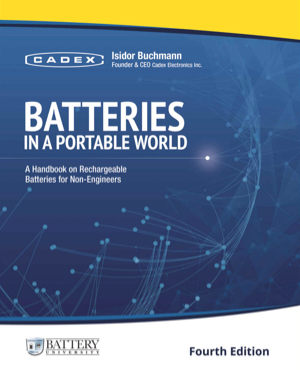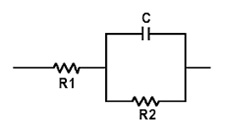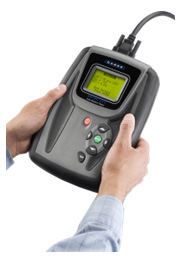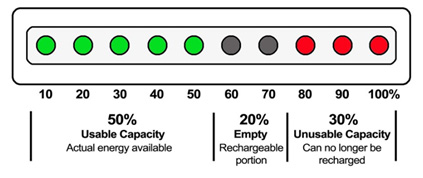Battery users want state-of-charge (SoC) and remaining runtime clearly displayed on their devices. Smartphones apps do this in an amazing way, but one questions the resource on which the information is based on. While data can easily be digitized for a make-believe show, the electrochemical battery, the heart of the power source, is complex, multifaceted and poorly understood.
Most users see the battery as an energy storage device resembling a fuel tank dispensing liquid fuel. For simplicity reasons, a battery can indeed be compared as such a vessel; however, measuring stored energy in an electrochemical device is far more complex than drawing fluid from a fixed container.
While a regular fuel gauge is static and measures liquid flowing from a tank of known size, the battery fuel gauge is dynamic and has unconfirmed definitions. The open circuit voltage (OCV) provides only rough SoC estimations of a vessel that is gradually diminishing in size. Even if the battery capacity has dropped from 100% to 50% with usage and age, the fuel gauge will still display 100% charge after a recharge. One asks: “100% of what?” No relationship exists between SoC and state-of-health (SoH), and showing SoC while hiding SoH is a major drawback of most battery fuel gauges. Considering these limitations, battery users begin to understand why battery fuel gauges are notoriously inaccurate.
The most simplistic way to read SoC is by voltage, but this can be inaccurate and here is why. Batteries within a given chemistry have dissimilar architectures and deliver unique voltage profiles. Temperature also plays a role; heat raises the voltage and cold lowers it. In addition, charging and discharging agitate the battery and the voltage no longer represents a correct SoC reference. A battery requires few hours of rest to regain equilibrium, and for lead acid this can be 24 hours. Loads and charge currents distort the voltage further, but one of the largest challenges is the flat discharge voltage curve of some lithium-based systems. This is especially evident with lithium-iron phosphate.
In spite of these limitations, voltage-based SoC somehow works. Reasonably good accuracies are attainable by compensating for irregularities and hiding some reserve capacity. No one will ever know how much energy is left in the battery unless one runs out of power.
Battery sensing as part of a battery management system (BMS) is making inroads into vehicles. Figure 1 shows a sensor for a starter battery that reads voltage, current and temperature to provide SoC and detect anomalies. These devices perform reasonably well when the battery is new but lose accuracy with time. Aging occurs differently when operating the battery at high temperatures or exposing it to harsh loading. False alarms are common as a one-size-fits-all algorithm to compensate for aging is difficult to implement.
Figure 1: Battery sensor for starter battery The sensor reads voltage, current and temperature to estimate state-of-charge and detect anomalies; capacity assessment is not possible. |
BMS also observes batteries in mobile phones, laptops, medical equipment, electric vehicles and other electronic devices. The management system protects lithium-ion cells from over-voltage, prevents excess current and detects temperature extremes to maintain safe operation and attain a long battery life. BMS also estimates SoC, reports secondary data, and sometimes also perform cell balancing. Advanced systems include coulomb counting the track in and out-flowing currents.
Coulomb counting improves the BMS but this is not totally foolproof; the outflowing energy is always less than what had been fed into the battery. Internal losses and self-discharge contribute to this deficit. Over time, a tracking error develops between the electrochemical and digital battery that must be corrected through calibration by applying one or several charge and discharge cycles. Periodic cycling can be omitted if the battery receives regular full discharges on its own accord.
Modern fuel gauges include a learn function that observes user patterns. Learn also measures how much energy the battery delivered on the previous discharge and notes charge times because a faded battery charges quicker than a good one as there is less to fill. Some systems also record cycle count, depth of discharge, loading conditions and temperature to derive at battery state-of-health (SoH). A BMS with learn may omit calibration; capacity estimations are possible but the battery must remain with the host. Most batteries in a mobile phones, laptops and car are subservient to the host and would qualify.
Capacity is the leading health indicator that discloses how much energy a battery can hold. Capacity also determines the runtime and governs the end-of-battery-life. There are three methods to estimate capacity: [1] by fully discharging a charged battery and tracking the elapsed time; [2] by observing values such as voltages, internal resistance, charge and discharge times; and [3] by examining the electrochemical battery with a frequency spectroscopy as if to do an “x-ray” scan. This article looks at the latest advances in electrochemical impedance spectroscopy (EIS), a technology that goes to the heart of the battery.
Battery Diagnostics and Monitoring
The ultimate goal is to test a battery in a few seconds. Battery test devices are available that claim to do this, but most rely on voltage and internal resistance readings. Lead acid and Li-ion batteries have improved; better electrolytes keep the internal resistance low by reducing corrosion. This makes resistive measurements obsolete as a quick and simple SoH check.
To examine the relationship between resistance and capacity, Cadex examined 175 aging starter batteries and found a correlation of only 0.55. A perfect equal would be 1. Li-ion behaves similarly to lead acid; however nickel-based batteries can still be assessed by a resistive measurement.
Asserting that a battery tester based on internal resistance is capable of estimating capacity is misleading. Promoting features that lay outside the equipment’s capabilities confuses the industry into believing that multifaceted results are attainable with basic test functions. Manufacturers are aware of the complexity of evaluating batteries, but this does not prevent them from over-promising. An analogy can be made with a shampoo that promises to grow lush hair on a man’s baldhead.
Scientists place high confidence in electrochemical impedance spectroscopy. EIS scans a battery with a frequency that ranges from 1–2000Hz. The reflected signal produces a Nyquist plot that characterizes the individual components of the Randles model. Randles is a representation of a battery consisting of ohmic and reactive components. A simplistic model is illustrated in Figure 2. Although EIS is capable of reading the individual values by extraction, capacity estimation is not possible.
| Figure 2: Randles model of a lead acid battery The overall battery resistance consists of ohmic resistance, as well as inductive and capacitive reactance. The values differ for each battery. |
Cadex Electronics advanced EIS one step further and developed multi-model electrochemical impedance spectroscopy or Spectroä for short. The Spectro™ engine is placed in the Spectro CA-12, a handheld battery tester that is capable of reading battery capacity, CCA and state-of-charge of a lead acid battery in a non-invasive 15-second test. The instrument scans a battery with a 20-2,000 Hertz signal as if to take a landscape, and a DSP (digital signal processor) crunches through 40 million transactions to calculate the results. The tester uses a matrix as a reference, the battery must have a SoC of at least 60%; the test can be done under a steady load but not while charging. Figure 3 illustrates the instrument.
| Figure 3: Spectro CA-12 battery tester Compact battery rapid-tester based on multi-model electrochemical impedance spectroscopy (EIS) reading capacity, CCA and state-of-charge in 15 seconds. Patented technology |
The Spectro™ engine can also be used for monitoring applications by adding the missing link, capacity. This converts a simple battery sensor to an advanced BMS. With capacity and state-of-charge known, a tri-state fuel gauge can be developed that reveals the available energy, the empty portion that can be refilled and the unusable part that is permanently lost. This leads to the all-encompassing state-of-function (SoF) reflecting a snapshot of a battery at any given time. Figure 4 illustrates this concept.
| Figure 4: Tri-state fuel gauge The tri-state fuel gauge estimates the usable capacity, empty portion and unusable part. |
Knowing SoF greatly improves battery validation, but some device manufacturers would be hesitant to show the consumer a capacity that is less that 100%, especially during the warranty period. Consumer concerns but aside, SoF will offer a significant advancement for industries that depend on batteries as it discloses the remaining battery capacity to calculates runtime and predict eventual replacement.
Developments are underway to also measure SoC with EIS. This will provide SoC estimation independent of voltage, enabling to read the remaining energy of a battery under a load. One of the challenges will be the development of matrices for each battery type of group. Matrices are lookup tables against which the battery is compared to estimate capacity and SoC.
Summary
More research will be needed in the field of battery diagnostics and monitoring. Current technologies lag behind those achieved in microelectronics and pharmaceuticals. It appears as if battery testing still dwells in medieval times. We don’t even have a reliable method to measure state-of-charge; assessing capacity, the leading health indicator, still lags behind.
Professor Mark Orazem compares the complexity of testing batteries with the Indian tale in which blind men touch an elephant to learn the substance. Each man feels a different part of the body, compares notes, but then disagrees at the end. Battery diagnostics is complex even for a sighted man as there is no single measurement that can quantify the condition of a battery with certainty. Only a set of carefully obtained characteristics will lead to a correct diagnostics.
Figure 5: Indian tale Story of blind men trying to figure out an elephant through touch. The tale provides insight into the relativism and opaqueness of a subject matter, such as a battery.
|

Comments
Looking for comments from the previous website?
Comments from the previous website are not compatible with our new commenting system but we have preserved them so our users can still reference and make use the information in them.





